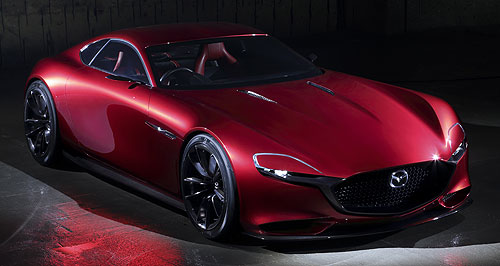News - MazdaMazda patents next-generation rotary engineSpin king: Mazda has not had a production-ready rotary powered sportscar since discontinuing the RX-8 in 2012 after nine years on the market. Patent files surface for Mazda’s new potentially mass production rotary engine8 Apr 2016 By TUNG NGUYEN JAPANESE car-maker Mazda has filed a patent for a redesigned rotary engine bringing it another step closer to a turbocharged sportscar revival which was previewed with last year’s RX-Vision concept. While Mazda has been without a rotary-powered sportscar since the discontinuation of the naturally aspirated RX-8 in 2012, this new-generation engine patent hints at the return of a turbocharged rotary, last seen on the RX-7 in 2002. The biggest difference in the new powerplant compared to its forebears is the rotation of the entire engine 180 degrees along the longitudinal axis, shifting the intake inlet to the bottom while moving the exhaust outlet to the top. According to Mazda’s US patent application that was discovered by American publication Car and Driver, “as a result, the space above the rotary piston engine can easily be secured and, for example, a large-sized exhaust turbocharger can be accommodated inside the engine room by being disposed above the rotary piston engine body”. A top-mounted turbocharger, and the use of a new fuel-injection system and weight-saving materials, could solve the lack of low-end power criticisms levelled at the RX-8’s 1.3-litre Rensis engine. Furthermore, the patent details, “the intake passage is disposed on one side of the rotary piston engine body and the exhaust passage is disposed above the rotary piston engine body”, which allows for longer intake and shorter exhaust passages resulting in a higher efficiency engine. While the engine is able to be mounted lower as the exhaust port no longer fouls front suspension components, it remains unclear if the new spark plug locations still make them difficult to reach. Although output specifications have not been detailed, expectations for Mazda’s next-generation rotary put power figures well above the 177kW achieved in the RX-8’s 1.3-litre Renesis engine and the 206kW produced in the twin-turbocharged RX-7, with some estimates putting it at up to 300kW. Fuel economy and CO2 emissions, two major criticisms of previous rotary engines, should also vastly improve from the 12.9 litres and 308 grams per 100 kilometres recorded in the RX-8. Although not turbocharged, the RX-Vision concept utilised a 1.6-litre rotary engine called SkyActiv-R and Mazda hinted that if a rotary sportscar were to make it to production, a turbocharged powerplant option could be included. Speaking to GoAuto at last month’s New York motor show, Mazda North American Operations president and CEO and Mazda Motor Corporation managing executive officer Masahiro Moro said there would be room for future sportscars such as the RX-Vision as long as there is demand. “If you continue to help and support improved Mazda business in the future, we will get there,” he said. “We pretty much know what we want to produce so that was a clear commitment in Tokyo motor show, as long as Mazda can elevate the business and brand value.” No time-frame for a halo rotary sportscar has been announced but 2017 marks the 50th anniversary of Mazda rotary vehicles, 2018 is the year of the RX-7’s 40th birthday and 2020 is the Hiroshima-based company’s centenary.  Read more2nd of November 2015  Tokyo show: Mazda ‘needs’ hi-po sportscarMazda Australia hopes to add sexy rotary sportscar to its roster29th of October 2015  Tokyo show: Turbo likely for Mazda rotaryMazda R&D chief details opportunities for rotary engine and future sportscar28th of October 2015  Tokyo show: Mazda reveals rotary visionMazda’s RX-Vision Concept previews future rotary-powered sportscar30th of September 2015  Tokyo show: Mazda previews new sportscarRelease of shady coupe image fuels rumours of Mazda’s return to rotary16th of September 2015  Frankfurt show: Mazda set to revive rotaryTokyo show likely launch pad for born-again Mazda rotary, maybe in hybrid |
Click to shareMazda articlesResearch Mazda Motor industry news |


















Facebook Twitter Instagram